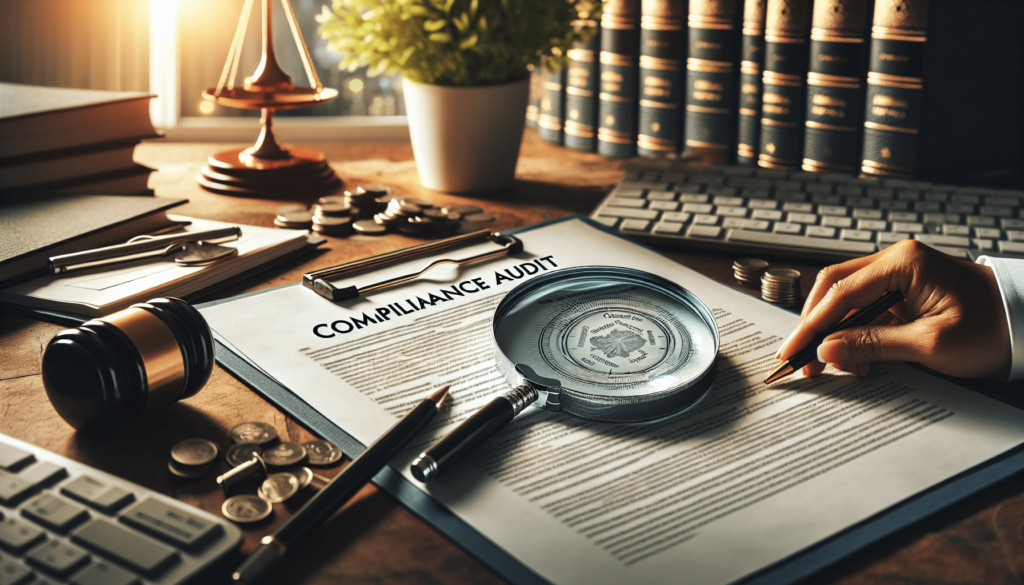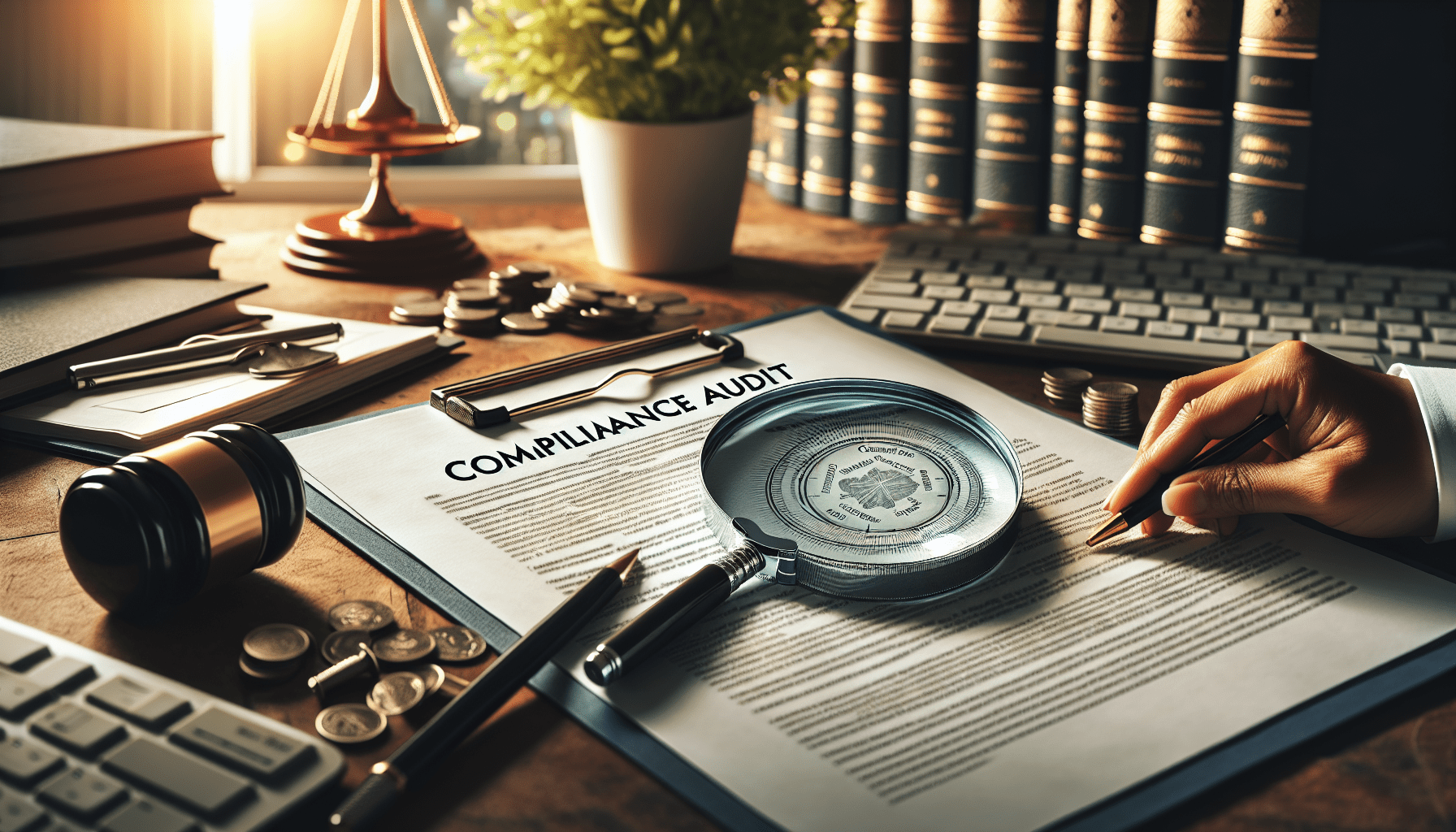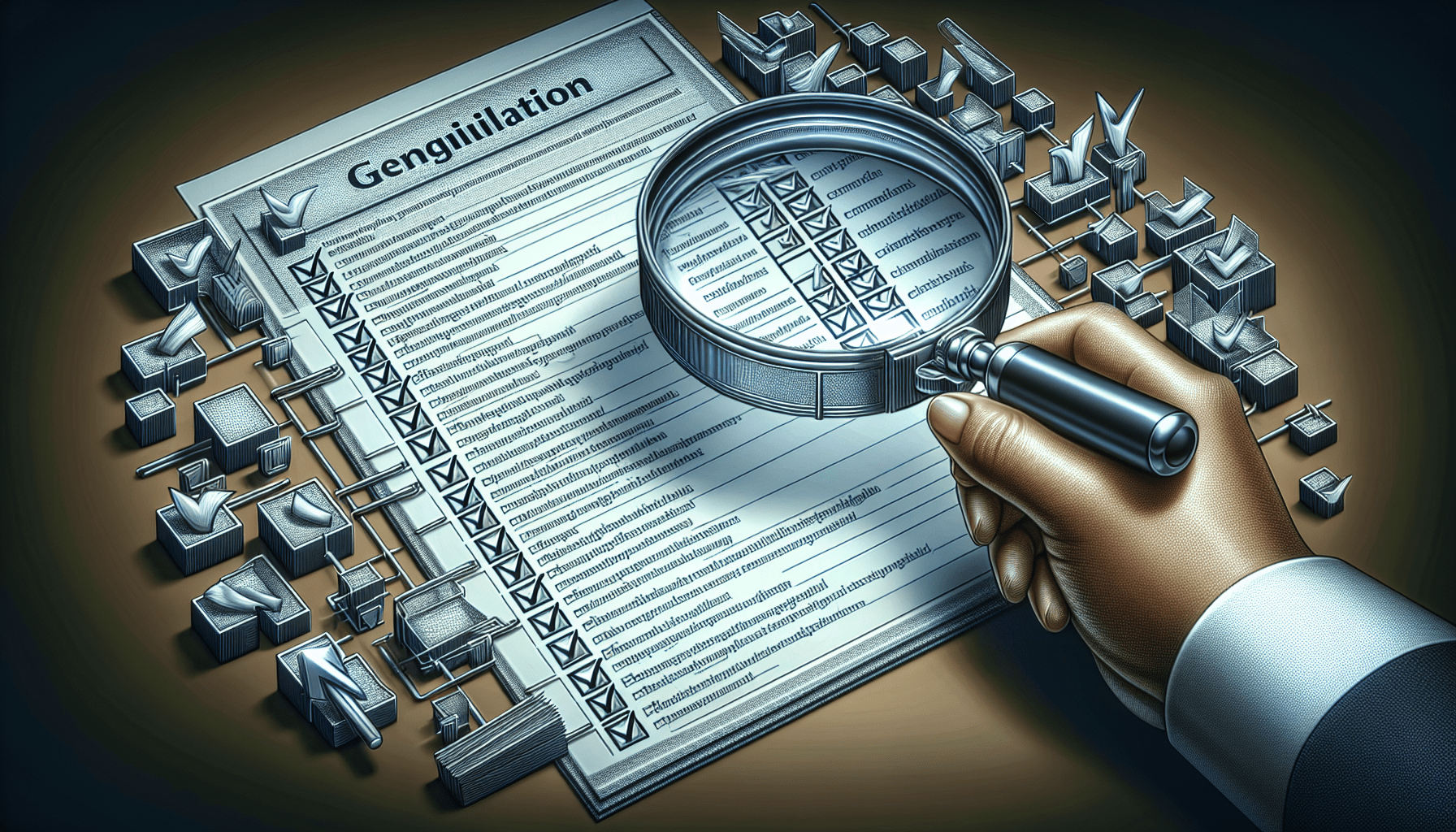In the fast-paced and highly regulated business world, compliance audits have become an indispensable tool to ensure organizations adhere to legal and regulatory requirements. This comprehensive guide provides a step-by-step approach to conducting compliance audits, equipping you with the knowledge and skills needed to effectively assess and mitigate risks. From establishing audit objectives and selecting the right audit team to conducting thorough assessments and developing robust action plans, this guide covers every aspect of the audit process. With practical tips and best practices, this ultimate guide will empower you to proactively manage compliance and foster a culture of integrity within your organization.

Understanding Compliance Audits
Definition and Purpose
Compliance audits are formal evaluations conducted to assess an organization’s adherence to applicable laws, regulations, industry standards, and internal policies. The purpose of these audits is to ensure that the organization operates in compliance with legal and ethical standards, mitigates risks, and protects stakeholders’ interests. Compliance audits provide an objective assessment of an organization’s controls, identify areas of noncompliance, and offer recommendations for improvement.
Types of Compliance Audits
Compliance audits can vary depending on the industry, regulatory requirements, and organizational needs. Here are some common types of compliance audits:
-
Financial Compliance Audit: This audit focuses on evaluating an organization’s financial controls and processes to ensure compliance with relevant accounting standards, tax laws, and internal financial policies.
-
IT Compliance Audit: IT compliance audits assess an organization’s information technology systems and practices to ensure the security, integrity, and confidentiality of data. These audits also ensure compliance with laws and regulations related to data privacy and cybersecurity.
-
Labor Compliance Audit: Labor compliance audits aim to ensure an organization’s compliance with labor laws, including minimum wage, working hours, overtime pay, health and safety standards, and employee benefits.
-
Environmental Compliance Audit: Environmental compliance audits assess an organization’s environmental practices to ensure compliance with environmental regulations, waste management procedures, and sustainability initiatives.
-
Healthcare Compliance Audit: Healthcare compliance audits focus on evaluating an organization’s adherence to healthcare regulations, privacy laws, patient confidentiality, and quality of care standards.
Preparing for a Compliance Audit
Assigning Responsibility
Before conducting a compliance audit, it is crucial to assign clear responsibilities to individuals or teams who will oversee the audit process. These responsible parties should have the necessary expertise and authority to coordinate the audit activities, gather relevant documentation, and communicate with internal stakeholders.
Developing an Audit Plan
A well-defined audit plan is essential for a successful compliance audit. It outlines the scope, objectives, and methodologies to be utilized during the audit. The plan should include a timeline, key milestones, resource allocation, and the identification of potential risks and challenges.
Gathering Relevant Documentation
To conduct an effective compliance audit, it is necessary to gather all relevant documentation related to applicable laws, regulations, policies, and procedures. This includes but is not limited to contracts, financial records, employment agreements, safety protocols, environmental impact assessments, and IT security measures.
Conducting a Preliminary Risk Assessment
A preliminary risk assessment helps identify the areas of highest risk and prioritizes them for audit focus. This assessment involves evaluating the organization’s activities, processes, and controls to determine potential risks to compliance. It aids in establishing the scope of the audit and identifying the necessary resources and expertise required.
Conducting the Compliance Audit
Establishing the Audit Scope
Defining the audit scope is crucial to ensure a comprehensive examination of the organization’s compliance. The audit scope outlines the specific areas, processes, departments, and time frames that will be included in the audit. It provides clarity on the extent to which the audit will assess compliance and serves as a guide throughout the audit process.
Performing Interviews
Interviews with key stakeholders, such as executives, managers, and employees, provide valuable insights into the organization’s compliance practices. These interviews aim to understand the organization’s processes, identify potential gaps or noncompliance issues, and gather information that may not be documented.
Reviewing Policies and Procedures
An in-depth review of the organization’s policies and procedures is critical to determine compliance with applicable laws and regulations. This review involves assessing whether policies are up-to-date, align with industry best practices, and are effectively communicated and understood across the organization. It also involves an examination of procedures to identify any deviations or weaknesses.
Analyzing Data and Reports
Data analysis plays a vital role in the compliance audit process. By examining relevant data and reports, auditors can identify trends, anomalies, or potential noncompliance issues. This analysis helps validate the organization’s compliance practices and highlight areas that require further examination.
Assessing Control Systems
Evaluating the organization’s control systems is essential to assess whether they effectively mitigate risks and ensure compliance. This assessment involves analyzing the design and implementation of control systems, including internal controls, segregation of duties, access controls, and monitoring mechanisms.
Performing Testing
Testing is a critical component of a compliance audit as it provides evidence of compliance or noncompliance. Auditors perform various testing procedures, such as sample testing, transaction testing, or system testing, to validate the effectiveness of controls and identify any instances of noncompliance.
Evaluating Compliance Audit Findings
Identifying Noncompliance
During a compliance audit, auditors identify areas of noncompliance where the organization fails to adhere to applicable laws, regulations, or internal policies. These findings may include instances of fraud, misconduct, gaps in controls, or inadequate documentation.
Assessing Severity and Impact
Once noncompliance is identified, auditors assess the severity and impact of the findings. This assessment helps determine the level of risk posed to the organization and its stakeholders. Severity may range from minor deviations to significant violations that could result in legal or reputational consequences.
Determining Root Causes
To address noncompliance effectively, auditors must determine the root causes behind the identified issues. This involves examining the underlying factors, such as inadequate training, flawed processes, or lack of oversight, that contributed to noncompliance. Understanding the root causes helps develop appropriate corrective actions.
Documenting Findings
Accurate and comprehensive documentation of audit findings is crucial for accountability, transparency, and future reference. Auditors should document each noncompliance issue, including details about the identified risk, its impact, the root causes, and supporting evidence. Proper documentation ensures that findings can be effectively communicated to relevant stakeholders and serves as a reference for future audits.

Developing Compliance Audit Recommendations
Identifying Improvement Opportunities
Based on the audit findings, auditors can identify improvement opportunities to enhance the organization’s compliance practices. These opportunities may include strengthening policies and procedures, improving training programs, implementing additional controls, or enhancing monitoring mechanisms.
Designing Corrective Actions
Corrective actions are specific steps taken to address the identified noncompliance and prevent its recurrence. Auditors should design actionable and practical corrective actions that directly target the root causes of noncompliance. These actions should be realistic, measurable, and aligned with the organization’s strategic goals.
Setting Priorities
When developing recommendations, auditors must prioritize areas of improvement based on their severity, impact, and the level of risk they pose to the organization. By setting priorities, resources can be allocated efficiently to address the most critical noncompliance issues first.
Formulating Recommendations
Clear and concise recommendations should be formulated based on the identified improvement opportunities and corrective actions. These recommendations should provide step-by-step guidance on how to address noncompliance, including the responsible parties, timelines, and resources needed. Recommendations should be feasible, actionable, and tailored to the organization’s specific circumstances.
Implementing Recommendations
Assigning Responsibility for Implementing Changes
To ensure effective implementation of recommendations, it is essential to assign clear responsibilities to individuals or teams. This includes designating accountable parties who will oversee the implementation process, monitor progress, and address any challenges that arise.
Developing an Implementation Plan
An implementation plan outlines the specific actions, timelines, and resources required to implement the recommended changes. This plan should include milestones, progress tracking mechanisms, and communication strategies to facilitate a smooth and structured implementation process.
Monitoring Progress
Monitoring the progress of implementing recommendations is essential to ensure that the desired changes are being effectively and efficiently implemented. Regular monitoring helps identify any obstacles, measure progress, and take remedial actions if necessary. Communication channels should be established to facilitate feedback and updates on the implementation process.
Reporting and Communicating Audit Results
Preparing the Audit Report
The audit report is a comprehensive document that summarizes the audit findings, recommendations, and the overall effectiveness of the organization’s compliance program. The report should be clear, concise, and well-structured, providing a detailed account of the audit process and its outcomes.
Ensuring Objectivity and Clarity
To maintain the integrity and credibility of the audit report, it is essential to ensure objectivity and clarity throughout the reporting process. Auditors should present facts and evidence accurately, avoid personal biases, and provide objective judgments.
Providing Timely Reviews
Timeliness is crucial when reporting and communicating audit results. Auditors should strive to complete the audit report promptly and adhere to the agreed-upon timelines for review and approval processes. Timely communication of findings enables prompt corrective actions and prevents further noncompliance.
Presenting Findings and Recommendations
When presenting audit findings and recommendations, auditors should use clear and concise language that is easily understood by all relevant stakeholders. Visual aids, such as charts or graphs, can be utilized to enhance understanding and facilitate effective communication.
Seeking Management Approval
Before finalizing the audit report, it is essential to seek management approval to ensure their buy-in and commitment to the recommended changes. Management approval signifies their acknowledgement of the findings and their willingness to prioritize and allocate resources to address the identified noncompliance.
Communicating Results to Relevant Stakeholders
Once the audit report is finalized, it should be communicated to all relevant stakeholders, including executives, board members, regulators, and internal teams responsible for implementing the recommended changes. Transparent communication of audit results fosters accountability, trust, and collaboration within the organization.
Following Up on Compliance Audit
Establishing Follow-up Measures
To ensure the effectiveness of corrective actions, follow-up measures should be established. These measures involve monitoring the progress of implementing recommendations, verifying sustained compliance, and identifying any new risks or noncompliance issues that may arise.
Tracking Implementation of Recommendations
Regular tracking of the implementation progress is crucial to ensure that corrective actions are being executed according to the plan. This tracking can be done through progress reports, status meetings, or dedicated software systems that provide real-time updates on the status of each recommendation.
Verifying Sustained Compliance
Auditors should periodically verify the sustained compliance of the organization after the implementation of recommendations. This verification helps evaluate the long-term effectiveness of the corrective actions and ensures that noncompliance does not resurface over time.
Updating Compliance Program
Based on the lessons learned from the compliance audit and the effectiveness of the implemented recommendations, it may be necessary to update the organization’s compliance program. This includes revising policies and procedures, enhancing training programs, strengthening control systems, and continuously monitoring regulatory changes.
Common Challenges in Compliance Auditing
Keeping Up with Regulatory Changes
Compliance auditors often face challenges in keeping up with rapidly evolving laws, regulations, and industry standards. Staying knowledgeable and up-to-date requires continuous training, professional development, and maintaining a network of contacts in the relevant regulatory fields.
Navigating Complex Organizational Structures
Large organizations with complex organizational structures present challenges in conducting compliance audits. Auditors must navigate intricate reporting lines, diverse business units, and varying compliance practices within the organization. Building relationships and collaborating with key stakeholders across different levels and departments is crucial to gather accurate and comprehensive information.
Addressing Resistance to Auditing
Resistance to auditing can arise from employees or management who may perceive audits as invasive or potentially uncovering unfavorable findings. Auditors must work proactively to build trust, communicate the benefits of compliance audits, and foster a positive compliance culture within the organization.
Dealing with Limited Resources
Limited resources, such as time, budget, and personnel, can challenge auditors in conducting thorough compliance audits. Prioritizing key areas of risk, utilizing technology, and leveraging risk-based approaches can help optimize resource allocation and maximize the effectiveness of compliance audits.
Best Practices for Conducting Compliance Audits
Maintaining Independence and Objectivity
Compliance auditors must maintain independence and objectivity throughout the audit process. They should avoid conflicts of interest and report their findings without bias or influence. Independence ensures the integrity and credibility of the audit results.
Utilizing Technology
Leveraging technology can enhance the efficiency and effectiveness of compliance audits. Audit management software, data analytics tools, and automated workflows help streamline processes, analyze large datasets, and facilitate real-time monitoring of compliance activities.
Leveraging Risk-Based Approaches
Adopting a risk-based approach allows auditors to focus their efforts on areas of highest risk and allocate resources accordingly. By identifying and prioritizing risks, auditors can design effective audit procedures, implement targeted testing, and develop recommendations that address the most critical compliance issues.
Promoting Collaboration and Cooperation
Successful compliance audits require collaboration and cooperation among auditors, management, and employees. Building relationships, fostering open communication channels, and involving key stakeholders throughout the audit process increases the likelihood of meaningful and sustainable improvements in compliance practices.
Investing in Training and Education
Continuous training and education are vital for compliance auditors to stay updated on regulatory changes, industry best practices, and evolving compliance trends. Professional development programs, certifications, and participation in industry associations enable auditors to enhance their skills and knowledge, ultimately improving the quality of compliance audits.
In conclusion, conducting compliance audits is crucial for organizations to achieve and maintain adherence to laws, regulations, and internal policies. By understanding the purpose of compliance audits, preparing diligently, conducting comprehensive evaluations, evaluating findings, developing recommendations, implementing changes, reporting results, and following up on the audit process, organizations can enhance their compliance practices, mitigate risks, and protect their stakeholders’ interests. While compliance audits may present challenges, adopting best practices, utilizing technology, promoting collaboration, and investing in training enable auditors to efficiently and effectively carry out compliance audits that drive organizational compliance and success.



